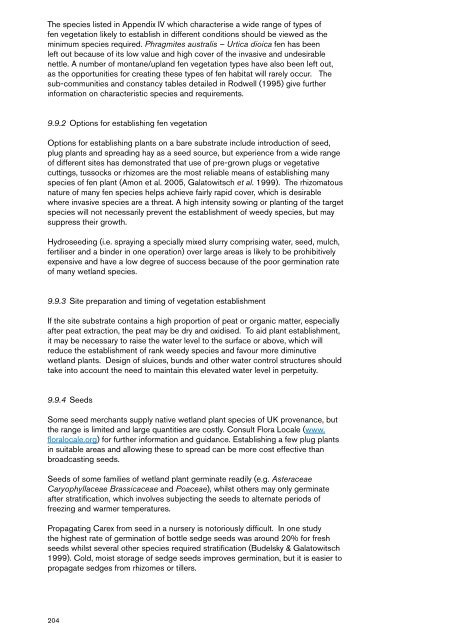Fen Management Handbook - Scottish Natural Heritage
Fen Management Handbook - Scottish Natural Heritage
Fen Management Handbook - Scottish Natural Heritage
Create successful ePaper yourself
Turn your PDF publications into a flip-book with our unique Google optimized e-Paper software.
The species listed in Appendix IV which characterise a wide range of types of<br />
fen vegetation likely to establish in different conditions should be viewed as the<br />
minimum species required. Phragmites australis – Urtica dioica fen has been<br />
left out because of its low value and high cover of the invasive and undesirable<br />
nettle. A number of montane/upland fen vegetation types have also been left out,<br />
as the opportunities for creating these types of fen habitat will rarely occur. The<br />
sub-communities and constancy tables detailed in Rodwell (1995) give further<br />
information on characteristic species and requirements.<br />
9.9.2 Options for establishing fen vegetation<br />
Options for establishing plants on a bare substrate include introduction of seed,<br />
plug plants and spreading hay as a seed source, but experience from a wide range<br />
of different sites has demonstrated that use of pre-grown plugs or vegetative<br />
cuttings, tussocks or rhizomes are the most reliable means of establishing many<br />
species of fen plant (Amon et al. 2005, Galatowitsch et al. 1999). The rhizomatous<br />
nature of many fen species helps achieve fairly rapid cover, which is desirable<br />
where invasive species are a threat. A high intensity sowing or planting of the target<br />
species will not necessarily prevent the establishment of weedy species, but may<br />
suppress their growth.<br />
Hydroseeding (i.e. spraying a specially mixed slurry comprising water, seed, mulch,<br />
fertiliser and a binder in one operation) over large areas is likely to be prohibitively<br />
expensive and have a low degree of success because of the poor germination rate<br />
of many wetland species.<br />
9.9.3 Site preparation and timing of vegetation establishment<br />
If the site substrate contains a high proportion of peat or organic matter, especially<br />
after peat extraction, the peat may be dry and oxidised. To aid plant establishment,<br />
it may be necessary to raise the water level to the surface or above, which will<br />
reduce the establishment of rank weedy species and favour more diminutive<br />
wetland plants. Design of sluices, bunds and other water control structures should<br />
take into account the need to maintain this elevated water level in perpetuity.<br />
9.9.4 Seeds<br />
Some seed merchants supply native wetland plant species of UK provenance, but<br />
the range is limited and large quantities are costly. Consult Flora Locale (www.<br />
floralocale.org) for further information and guidance. Establishing a few plug plants<br />
in suitable areas and allowing these to spread can be more cost effective than<br />
broadcasting seeds.<br />
Seeds of some families of wetland plant germinate readily (e.g. Asteraceae<br />
Caryophyllaceae Brassicaceae and Poaceae), whilst others may only germinate<br />
after stratification, which involves subjecting the seeds to alternate periods of<br />
freezing and warmer temperatures.<br />
Propagating Carex from seed in a nursery is notoriously difficult. In one study<br />
the highest rate of germination of bottle sedge seeds was around 20% for fresh<br />
seeds whilst several other species required stratification (Budelsky & Galatowitsch<br />
1999). Cold, moist storage of sedge seeds improves germination, but it is easier to<br />
propagate sedges from rhizomes or tillers.<br />
204

















